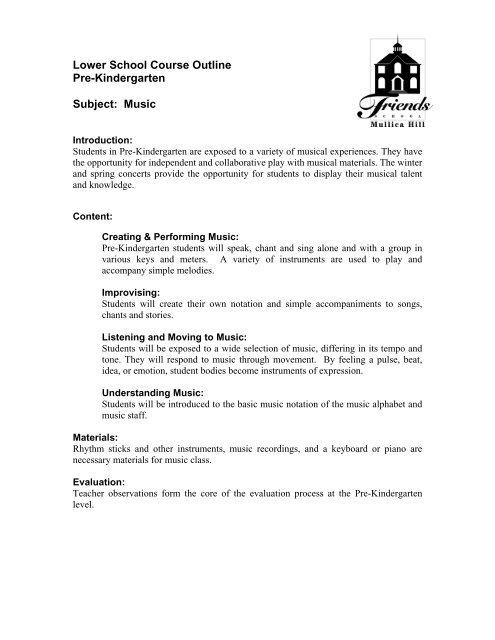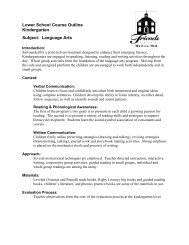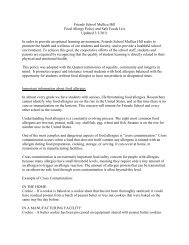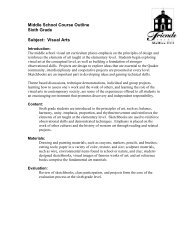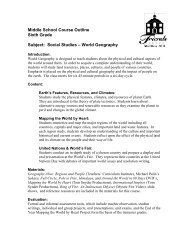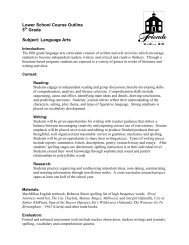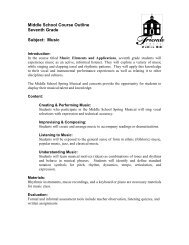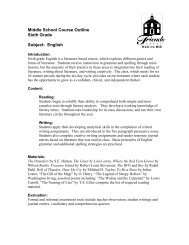Lower School Course Outline Pre-Kindergarten Subject: Music
Lower School Course Outline Pre-Kindergarten Subject: Music
Lower School Course Outline Pre-Kindergarten Subject: Music
Create successful ePaper yourself
Turn your PDF publications into a flip-book with our unique Google optimized e-Paper software.
<strong>Lower</strong> <strong>School</strong> <strong>Course</strong> <strong>Outline</strong><br />
<strong>Pre</strong>-<strong>Kindergarten</strong><br />
<strong>Subject</strong>: <strong>Music</strong><br />
Introduction:<br />
Students in <strong>Pre</strong>-<strong>Kindergarten</strong> are exposed to a variety of musical experiences. They have<br />
the opportunity for independent and collaborative play with musical materials. The winter<br />
and spring concerts provide the opportunity for students to display their musical talent<br />
and knowledge.<br />
Content:<br />
Creating & Performing <strong>Music</strong>:<br />
<strong>Pre</strong>-<strong>Kindergarten</strong> students will speak, chant and sing alone and with a group in<br />
various keys and meters. A variety of instruments are used to play and<br />
accompany simple melodies.<br />
Improvising:<br />
Students will create their own notation and simple accompaniments to songs,<br />
chants and stories.<br />
Listening and Moving to <strong>Music</strong>:<br />
Students will be exposed to a wide selection of music, differing in its tempo and<br />
tone. They will respond to music through movement. By feeling a pulse, beat,<br />
idea, or emotion, student bodies become instruments of expression.<br />
Understanding <strong>Music</strong>:<br />
Students will be introduced to the basic music notation of the music alphabet and<br />
music staff.<br />
Materials:<br />
Rhythm sticks and other instruments, music recordings, and a keyboard or piano are<br />
necessary materials for music class.<br />
Evaluation:<br />
Teacher observations form the core of the evaluation process at the <strong>Pre</strong>-<strong>Kindergarten</strong><br />
level.
<strong>Lower</strong> <strong>School</strong> <strong>Course</strong> <strong>Outline</strong><br />
<strong>Kindergarten</strong><br />
<strong>Subject</strong>: <strong>Music</strong><br />
Introduction:<br />
Students in <strong>Kindergarten</strong> are exposed to a variety of musical experiences. They have the<br />
opportunity for independent and collaborative play with musical materials. The winter<br />
and spring concerts provide the opportunity for students to display their musical talent<br />
and knowledge.<br />
Content:<br />
Creating & Performing <strong>Music</strong>:<br />
Students will begin to sing independently, on pitch and in rhythm, with a group in<br />
various keys and meters. Students will use a variety of instruments to play and<br />
accompany simple melodies and perform alone and in small ensembles on various<br />
rhythm instruments.<br />
Improvising:<br />
Children will create their own notation and create simple accompaniments to<br />
songs, chants and stories.<br />
Listening and Moving to <strong>Music</strong>:<br />
Students will be exposed to a wide selection of music, differing in its tempo and<br />
tone. They will respond to music through movement. By feeling a pulse, beat,<br />
idea, or emotion, student bodies become instruments of expression.<br />
Understanding <strong>Music</strong>:<br />
Students will be introduced to the basic music notation of note and rest values.<br />
Materials:<br />
Rhythm sticks and other instruments, music recordings, and a keyboard or piano are<br />
necessary materials for music class.<br />
Evaluation:<br />
Teacher observations form the core of the evaluation process at the <strong>Kindergarten</strong> level.
<strong>Lower</strong> <strong>School</strong> <strong>Course</strong> <strong>Outline</strong><br />
First Grade<br />
<strong>Subject</strong>: <strong>Music</strong><br />
Introduction:<br />
Students in First Grade are exposed to a variety of musical experiences. They have a<br />
hands-on introduction to the violin. Through their violin instruction they begin to pull<br />
together their basic musical knowledge and apply musical skills that they have learned.<br />
Violin class instruction also helps to develop fine motor skills, rhythmic and spacial<br />
reasoning skills. The winter and spring concerts provide the opportunity for students to<br />
display their musical talent and knowledge.<br />
Content:<br />
Creating & Performing <strong>Music</strong>:<br />
Students will begin to sing independently, on pitch and in rhythm, and begin to<br />
work on appropriate timbre, diction and posture. The first grade violin class is an<br />
introduction to the violin, learning its parts and how to hold the violin and bow in<br />
the correct way. Students will learn to play simple melodies on all four strings of<br />
the violin and other rhythmic and melodic instruments and will perform alone and<br />
in small ensembles.<br />
Improvising:<br />
Children will begin to improvise echoes in the same rhythmic and melodic style<br />
the instructor gives them.<br />
Listening and Moving to <strong>Music</strong>:<br />
Students will be exposed to a wide selection of music, differing in its tempo and<br />
tone. They will respond to music through movement. By feeling a pulse, beat,<br />
idea, or emotion, student bodies become instruments of expression.<br />
Understanding <strong>Music</strong>:<br />
Student will apply their understanding of basic music notation through playing the<br />
violin and other rhythmic and melodic musical instruments. They are introduced<br />
to the musical staff and treble clef. Students learn to differentiate between space<br />
notes and line notes, read quarter notes and rest, and find the notes for open<br />
strings D and A on the staff.<br />
Materials:<br />
Rhythmic sticks and other instruments, music recordings, student violins, and a keyboard<br />
or piano are necessary materials for music class.<br />
Evaluation:<br />
Teacher observations form the core of the evaluation process at the first grade level.
<strong>Lower</strong> <strong>School</strong> <strong>Course</strong> <strong>Outline</strong><br />
Second Grade<br />
<strong>Subject</strong>: <strong>Music</strong><br />
Introduction:<br />
Second Grade students begin to expand their knowledge of music notation (rhythm &<br />
pitch) and apply it to various rhythmic and melodic instruments. Violin class instruction<br />
helps to develop fine motor skills, rhythmic and spacial reasoning skills. The winter and<br />
spring concerts provide the opportunity for students to display their musical talent and<br />
knowledge.<br />
Content:<br />
Creating & Performing <strong>Music</strong>:<br />
Students will begin to sing expressively, with appropriate dynamics, phrasing, and<br />
interpretation. They will perform easy rhythmic, melodic and chordal patterns on<br />
rhythmic and melodic instruments. While maintaining emphasis on posture and<br />
position, students participate in more complex theory and note-reading activities.<br />
They learn and play the notes E, F-sharp, and G on the D-string in addition to the<br />
four notes already mastered in the first grade.<br />
Improvising:<br />
Students will improvise simple rhythmic and ostinato accompaniments.<br />
Listening to <strong>Music</strong>:<br />
Students will begin to demonstrate perceptual skills, moving and describing aural<br />
examples of music of various styles.<br />
Understanding <strong>Music</strong>:<br />
Students will begin reading music notation (whole notes, half notes, dotted half<br />
notes, quarter notes and rests) and learn to read all notes on the treble clef staff.<br />
They apply their understanding to various rhythmic and melodic instruments.<br />
Materials:<br />
Rhythm sticks and other instruments, music recordings, student violins, and a keyboard<br />
or piano are necessary materials for music class.<br />
Evaluation:<br />
Teacher observations form the core of the evaluation process at the second grade level.
<strong>Lower</strong> <strong>School</strong> <strong>Course</strong> <strong>Outline</strong><br />
Third Grade<br />
<strong>Subject</strong>: <strong>Music</strong><br />
Introduction:<br />
Third grade students will expand their knowledge of music notation. They will apply<br />
their knowledge through singing and performing on various rhythmic and melodic<br />
instruments. Violin class instruction helps to develop fine motor skills, rhythmic and<br />
spacial reasoning skills. The winter and spring concerts provide the opportunity for<br />
students to display their musical talent and knowledge.<br />
Content:<br />
Creating & Performing <strong>Music</strong>:<br />
Students will begin to sing a varied repertoire of songs from diverse cultures and<br />
using ostinatos, partner songs, and rounds. They will perform in-groups, blending<br />
instrumental timbres and matching dynamic levels. Building on a foundation of<br />
good violin playing position, students learn notes on the A-string and E-string.<br />
Improvising:<br />
Students will improvise simple rhythmic variations and simple melodic<br />
embellishments on familiar melodies.<br />
Listening to <strong>Music</strong>:<br />
Students will begin to explore form in music.<br />
Understanding <strong>Music</strong>:<br />
Students will begin reading notation – various meters and simple pitch in both<br />
treble and bass clef. They learn to read not only the notes within the treble clef<br />
staff but also notes on ledger lines above and below the staff.<br />
Materials:<br />
Rhythmic instruments, music recordings, student violins, and a keyboard or piano are<br />
necessary materials for music class.<br />
Evaluation:<br />
Teacher observations form the core of the evaluation process at the third grade level.
<strong>Lower</strong> <strong>School</strong> <strong>Course</strong> <strong>Outline</strong><br />
Fourth Grade<br />
<strong>Subject</strong>: <strong>Music</strong><br />
Introduction:<br />
Fourth grade students will be introduced to the recorder in addition to their experiences<br />
with percussion instruments. As they learn to play the recorder, they are able to apply<br />
their knowledge of music notation and musical form. The winter and spring concerts<br />
provide the opportunity for students to display their musical talent and knowledge.<br />
Content:<br />
Creating & Performing <strong>Music</strong>:<br />
Students will learn to sing accurately and with good breath control throughout<br />
their singing ranges. Students play independent instrumental parts while other<br />
students sing or play contrasting parts.<br />
Improvising & Composing:<br />
Students will work on creating short musical pieces using improvised sound<br />
sources. In recorder class, they learn to play by ear through expressive<br />
improvisation games.<br />
Listening to <strong>Music</strong>:<br />
Students will learn to identify simple music forms when presented aurally.<br />
Understanding <strong>Music</strong>:<br />
Students will begin to use a system (that is, syllable, numbers, or letters) to read<br />
simple pitch notation in the treble clef in major keys.<br />
Materials:<br />
Rhythmic instruments, music recordings, student recorders, and a keyboard or piano are<br />
necessary materials for music class.<br />
Evaluation:<br />
Teacher observations form the core of the evaluation process at the fourth grade level.
<strong>Lower</strong> <strong>School</strong> <strong>Course</strong> <strong>Outline</strong><br />
Fifth Grade<br />
<strong>Subject</strong>: <strong>Music</strong><br />
Introduction:<br />
Fifth grade students will be able to demonstrate their musical knowledge by participating<br />
in choral and instrumental ensembles. Recorder class instruction continues throughout<br />
fifth grade. The winter and spring concerts provide the opportunity for students to<br />
display their musical talent and knowledge.<br />
Content:<br />
Creating & Performing <strong>Music</strong>:<br />
Students will begin to sing accurately and with good breath control throughout<br />
their singing ranges, alone and in ensembles. Students will play by ear simple<br />
melodies on a melodic instrument and simple accompaniments on a harmonic<br />
instrument.<br />
Improvising & Composing:<br />
Students will use standard notation to record write their musical ideas and the<br />
musical ideas of others. In recorder class, they learn to play by ear through<br />
expressive improvisation games.<br />
Listening to <strong>Music</strong>:<br />
Students will identify the sounds of a variety of instruments, including many<br />
orchestral and band instruments.<br />
Understanding <strong>Music</strong>:<br />
Students will play simple melodies in both treble and bass clef staffs.<br />
Materials:<br />
Rhythmic instruments, music recordings, student recorders, and a keyboard or piano are<br />
necessary materials for music class.<br />
Evaluation:<br />
Teacher observations form the core of the evaluation process at the fifth grade level.
Middle <strong>School</strong> <strong>Course</strong> <strong>Outline</strong><br />
Sixth Grade<br />
<strong>Subject</strong>: <strong>Music</strong><br />
Introduction:<br />
Sixth grade students will begin exploring form, structure, and composition. They will<br />
apply this knowledge to their vocal and instrumental performance experiences as well as<br />
relating it to other disciplines and cultures. The Middle <strong>School</strong> Spring <strong>Music</strong>al and<br />
concerts provide the opportunity for students to display their musical talent and<br />
knowledge.<br />
Content:<br />
Creating & Performing <strong>Music</strong>:<br />
Students will begin to sing a repertoire of vocal literature with expression and<br />
technical accuracy. They will perform on one instrument accurately and<br />
independently, alone and in a small or large ensemble.<br />
Improvising & Composing:<br />
Students will create and arrange music to accompany readings or dramatizations.<br />
Listening to <strong>Music</strong>:<br />
Students will describe specific events in a given aural example.<br />
Understanding <strong>Music</strong>:<br />
Students will identify and define standard notation symbols for pitch, rhythm,<br />
dynamics, tempo, articulation, and expression.<br />
Materials:<br />
Rhythmic instruments, music recordings, and a keyboard or piano are necessary materials<br />
for music class.<br />
Evaluation:<br />
Teacher observations form the core of the evaluation process at the sixth grade level.


